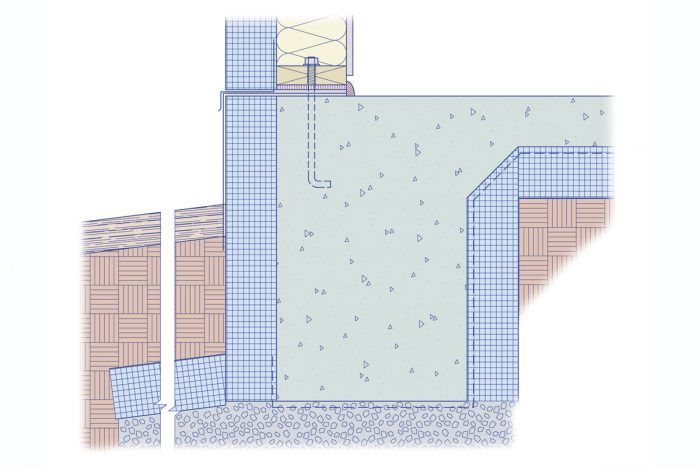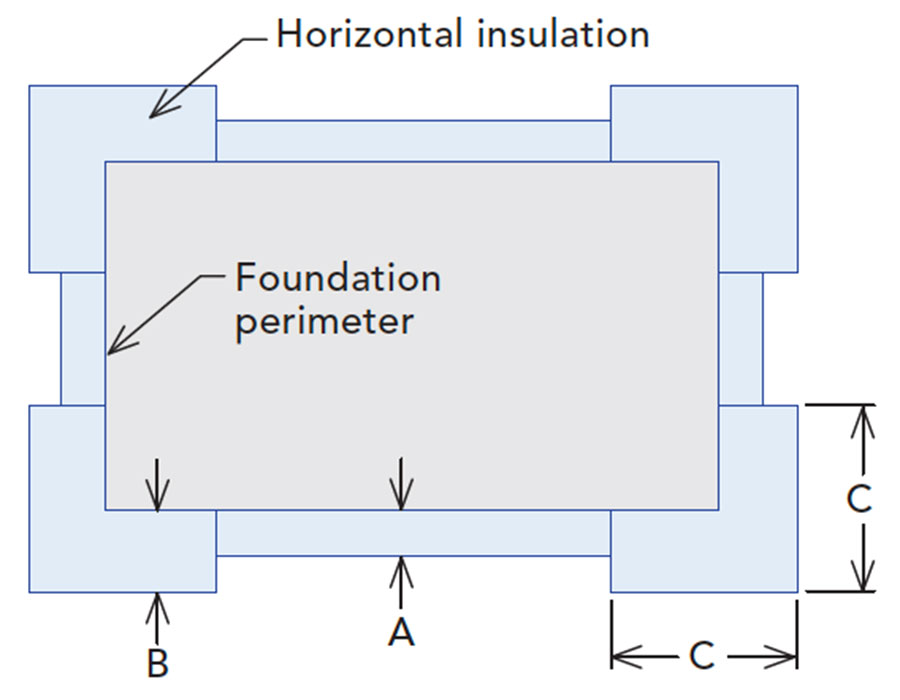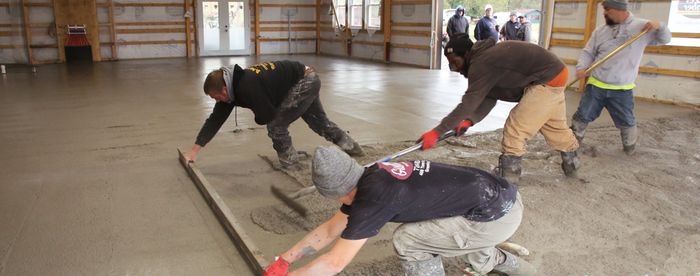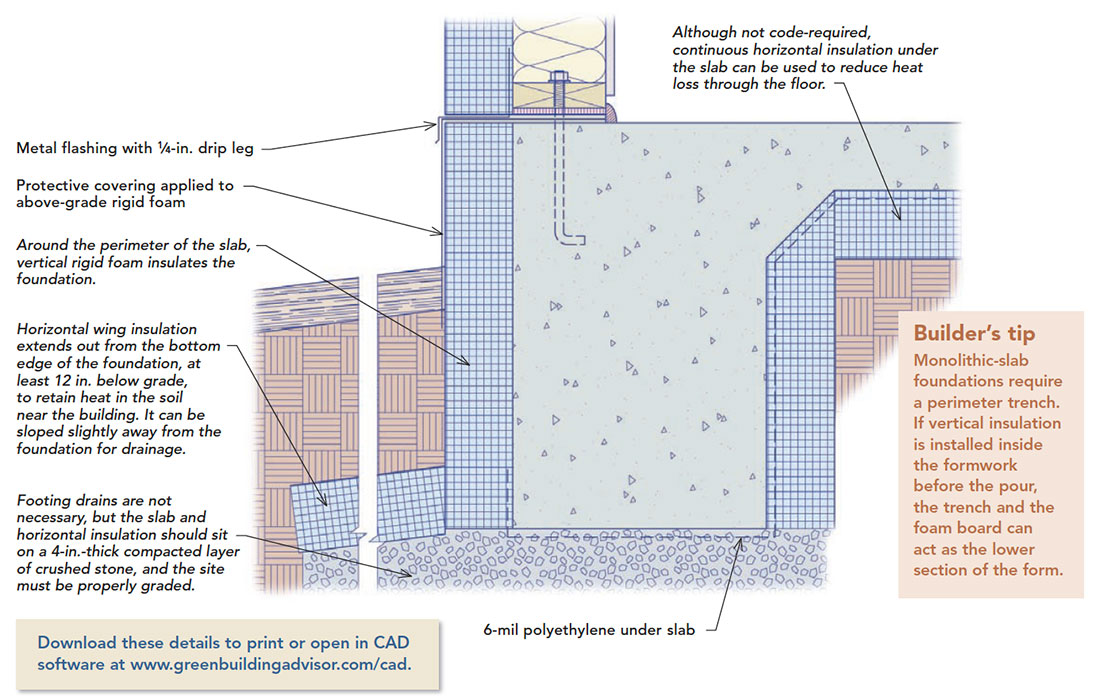Frost-Protected Shallow Foundations
Use less concrete and save on labor with this alternative method for building an energy-efficient foundation for a house in a cold climate.

The footings of most foundations are placed below the frost depth. In colder areas of the United States, this can mean excavating and pouring concrete 4 ft. or more below grade. If you include enough rigid-foam insulation around a foundation, however, you can keep the soil under the house warm enough to permit shallow excavations, which can be as little as 12 in. or 16 in. deep, even in northern areas.
So-called frost-protected shallow foundations usually consist of a monolithic (thick-edged) slab wrapped with vertical and horizontal rigid-foam insulation. Although the International Residential Code (IRC) does not require a shallow foundation to have insulation below the slab, omitting the subslab insulation is not a good idea. After all, the more insulation you have under the slab, the less heat will leak out of your house into the soil below.
These shallow foundations don’t depend on leaking building heat to keep the soil warm. Instead, horizontal wings of insulation extending outward from the bottom edge of the slab help to retain the natural warmth of the earth.
Either extruded-polystyrene (XPS) or denser types of expanded-polystyrene (EPS) insulation may be used to insulate a frost-protected shallow foundation. To account for the possible performance degradation of foam insulation that remains buried for years, designers “derate” the presumed R-value of XPS from its nominal value of R-5 per in. to R-4.5 per in. The amount of insulation you’ll need depends on the air-freezing index in your area. Coincidentally, because of existing energy-code requirements, you may already be insulating your foundation walls enough to achieve the necessary R-value for a shallow foundation.
Let’s say you’re building a frost-protected shallow foundation in a Minnesota town with an air-freezing index of 2500. According to code requirements for frost-protected shallow foundations found in Table R403.3 of the IRC, the minimum R-value of the vertical insulation at the perimeter of the slab is R-6.7 (about 1-1/2 in. of XPS). Ironically, the energy section of the IRC, which applies to all types of slabs, not just those that are frost-protected, requires more slab-edge insulation, R-10, for slabs commonly built with full-depth footings in this climate zone.
The R-value for the horizontal wing insulation in this example is R-4.9. Table R403.3 also specifies the minimum width and configuration of the wings.
Now that minimum energy-code requirements for slab insulation have overtaken the design requirements for a frost-protected shallow foundation, the line between a “conventional” slab-on-grade foundation and a frost-protected shallow foundation has been blurred. As a result, almost any monolithic slab complying with energy-code requirements can be turned into a frost-protected shallow foundation by adding the required wing insulation.
For more information, see “Revised Builder’s Guide to Frost Protected Shallow Foundations.”
Code requirements spell out how much insulation must be used in a frost-protected shallow foundation. Builders of high-performance houses, however, will probably opt for much higher R-values underneath the slab. In order to meet energy efficiency requirements in Passive House buildings, for example, designers often specify much more subslab insulation than required by code. This house, in fact, had a slab insulated to R-50, five times what the IRC requires.
Pros and a few caveats
Frost-protected shallow foundations have some advantages over conventional foundations:
- They require less excavation, so smaller equipment and less labor are involved.
- Less concrete is consumed.
- Monolithic slabs are formed and poured in one shot, speeding the work schedule.
- They typically cost 15% to 21% less than a conventional foundation, according to a study by the NAHB Research Center (now the Home Innovation Research Labs).
Frost-protected shallow foundations don’t make sense everywhere, though.
- If you live where frost depths are already shallow, don’t expect any savings in labor or material, although an insulated foundation may save energy dollars later.
- Frost-protected shallow foundations aren’t appropriate for steeply sloped sites or sites with permafrost.
- In areas that are heavily infested with termites, including the southeastern United States and most of California, the use of below-grade rigid-foam insulation is not necessarily a good idea.
- Deep-rooted perennial plants shouldn’t be planted above the shallow wing insulation that surrounds the house.
- The above-grade portions of the vertical foam insulation should be protected with a durable finish material, such as Protecto Wrap, Protecto Bond, or stucco over metal or fiberglass lath.
Dig less, insulate more
Because most rigid insulation is either 24 in. wide or 48 in. wide, it makes sense to design a frost-protected shallow foundation to be 24 in. deep at the perimeter, with 16 in. below grade and 8 in. above grade.
Air-freezing index determines R-value

To calculate the necessary R-value of the foam needed for a frost-protected shallow foundation, most designers look up the air-freezing index for the area in which they are building. The higher the index, the colder the climate. Design guidelines for frost-protected shallow foundations can be found in an American Society of Civil Engineers publication, “Design and Construction of Frost-Protected Shallow Foundations” (ASCE 32-01). However, most residential builders will probably find it easier to follow the prescriptive requirements for these foundations in section R403.3 of the IRC, also shown here.
—Martin Holladay is a contributing editor.
From Fine Homebuilding #216
Drawings facing page: Steve Baczek (top); Dan Thornton (center, bottom).
RELATED LINKS
- Rigid Mineral Wool Foundation Insulation Review — Fireproof, insect resistant, and able to drain water quickly, mineral wool offers extruded polystyrene some real competition.
- Insulating a Slab on Grade Foundation — Depending on your location, you may need rigid foam insulation under and around the edges of the slab.
- A Solid, Well-Insulated Foundation — A foundation made from insulating concrete forms is just the ticket for the FHB House project.








View Comments
Martin, I love the builder’s tip about pouring concrete directly into the EPS-lined trench. What method do you suggest for installing a perimeter French drain with this type of forming?
Since the FPSF has no basement or crawlspace and the top of the slab is above the surrounding grade there isn't a need for a perimeter drain. The soil grade should slope away from the foundation/structure.
We are planning to use a product by Build Smart called the J-Form. The J-Form combines form and insulation. The hard part we are facing is getting it through plan review even with stamped engineering plans. As the Article explains ASCE 32 is pivotal in explanation as some of it can go against the prescriptive code.
https://buildsmartna.com/product-page/#searchwp-modal-652ea0d21b1427a1bfa685e40d9bc1de
Great article, seems to check all the boxes for sustainability, energy, labor, engineering. The detail shows a monolithic slab...would this still work if you had a crawlspace situation, say, for an enclosed porch? Would you then mirror the detail from the exterior to the interior? i.e. Have your 12" deep horizontal wing insulation on the inside as well?